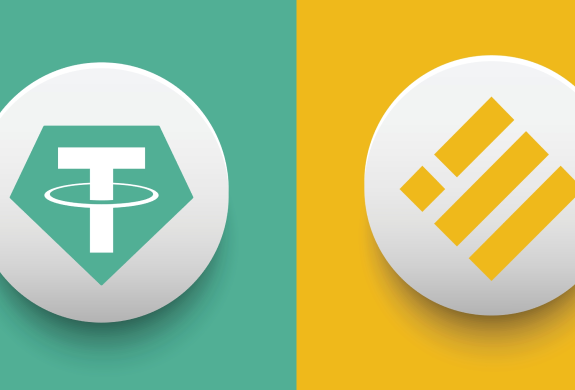It’s hardest to choose between two similar products, and it’s especially hard to choose between two stablecoins that have many similarities and are known among users — BUSD and USDT. Below we will dissect both coins in detail so that you can make a choice based on objective data and not on advertising, influencer advice, or sympathy for one brand or the other.

How USDT Came to Be
This Stablecoin appeared in 2012 as a startup called Mastercoin. The project developed a technology to launch new coins based on the bitcoin blockchain, which later became known as Omni Layer.

In 2013, the startup evolved and launched the first cryptocurrency with a peg to the dollar, it was called Realcoin.
Realcoin used to issue Proof of Reserves, a mechanism that checked the company’s reserves in bank accounts and, based on that data, burned or issued new coins to guarantee the peg. This mechanism is still used to mint new coins through Omni.
In 2014, the company rebranded itself as Tether, and Realcoin became USD Tether (USDT). The name distinguished the token from other altcoins and emphasized its link to the dollar.
In 2018, the company launched its stablecoin on the rapidly gaining Ethereum network and has been gradually spreading tokens to new blockchains and ecosystems ever since.
Currently, USDT remains the largest stablecoin on the crypto market with a $60B offering and support for 15 blockchains. The token enjoys first-mover advantages and is in demand among traders and investors despite litigation in ’17.
How BUSD Came to Be
BUSD came much later than its competitor – the stablecoin was launched in October 2019, as a joint product of Binance and Paxos. In this duo, Paxos acts as a custodian of the stablecoin’s fiat reserves and also redeems tokens at a nominal price from holders. In turn, Binance is the nominal owner and chief ambassador of stablecoin, providing the technical infrastructure and economic ecosystem for it.

BUSD originally appeared on the BSC network as a BEP-20 standard token and was positioned as a native Binance cryptocurrency staple. However, as the BSC ecosystem developed and Binance itself grew, the token’s capitalization, as well as the list of supported networks, began to grow.
Currently, BUSD is the third most capitalized cryptocurrency, behind only USDT and USDC. The popularity of the token is constantly growing due to the promotion of Binance, which offers BUSD holders a number of advantages: zero commissions, a wide range of trading pairs, and DeFi tools for earning.
BUSD vs USDT
A comparison table will help you better understand the key characteristics of each stablecoin.
| USDT | BUSD | |
| Year of Issue | 2014 on Omni protocol, 2018 on Ethereum. | 2019 |
| Market Offer | 69.35B | 21.66B |
| Issuer | Tether | Paxos in conjunction with Binance. |
| Collateral and Binding Mechanism | Centralized security, binding is guaranteed by the issuer. | Centralized security, binding is guaranteed by the issuer. |
| Composition of Collateral | 79.6% – Cash and Cash Equivalents6.7% – Secured Loans5.2% – Corporate Bonds8.3% – Other Investments | 67.3% – U.S. Treasury Debt25% – U.S. Treasury Reverse Repurchase Agreements7.7% – Cash Deposits and Cash Equivalents |
| Transparency | 15 networks, including Ethereum, Tron, Near, Solana, Omni, Avalanche, Polygon, etc. | According to Coinmarketcap, smart contracts are deployed in 8 networks, including BNB, Solana, Ethereum, and others. |
| DeFi | Most sites in supported networks. | The BUSD ecosystem is available here. |
| Markets | According to Coinmarketcap, the main liquidity of USDT is provided by large CEX: Coinbase, KuCoin, and Binance. | According to Coinmarketcap, the main liquidity of BUSD is provided by Binance and PancakeSwap. |
What BUSD and USDT Have in Common
BUSD and USDT belong to the group of centralized stablecoins and are among the top tokens in their market segment, so they have several common features:
- Binding and Collateral Mechanism – Both coins are backed centrally, by issuers’ assets. The available supply is regulated by the issuer’s decision. Tethering is secured by the issuer’s obligation to redeem the coin at a nominal price of $1.
- Multi-currency – both BUSD and USDT are available on multiple networks at once. Despite the same ticker, they can be tokens of completely different standards, intended for transfers in different blockchains.
Important: Always check the token standard before sending. If you send stablecoins to a wallet on a different network, they will simply disappear.
- Integration with DeFi – Both coins are the backbone of liquidity for DeFi platforms, though they focus on different market segments. You can easily exchange stablecoins through the aggregator/DEX or use them for farming. BUSD and USDT liquidity pools are available on the largest DEX in all supported networks.
- Both coins serve the same function – providing traders and investors with the ability to lock in income and stabilize their portfolios without having to exit to fiat. BUSD and USDT also form the majority of trading pairs on platforms in their ecosystems.
What Is The Difference Between BUSD and USDT?
Despite the technical and functional similarities, the tokens also have differences that may influence your decision when choosing:
- Scale – USDT’s capitalization is roughly three times that of BUSD, and Tether’s stablecoin is 10 times larger than its competitor in terms of trading volume. The number of supported USDT networks is twice that of BUSD. Tether is focused on the global crypto market without being tied to a specific blockchain and ecosystem, while BUSD’s reach is relatively limited.
- Custodians – Tether itself provides storage and management of fiat reserves, while Paxos performs this function for Binance Stablecoin. Paxos also assumes the obligation to redeem the token at a nominal price. That is, Binance is more of a BUSD brand rather than the actual owner. This is potentially an additional issuer risk for BUSD.
- Markets – Tether’s stablecoin is distributed across various CEXs, DEXs, blockchains, and venues. Therefore, USDT’s liquidity is more diversified than that of BUSD: most of the latter token’s trading pairs are concentrated on Binance and the closely related PanckakeSwap DEX ecosystem.
There is also a technical difference in token standards. Since the number of supported networks is different, BUSD and USDT cannot be considered interchangeable coins across all blockchains. This means that BUSD is simply not suitable for some ecosystems.
How to Buy BUSD or USDT
BUSD and USDT are among the top 10 cryptocurrencies by market capitalization and are available on most well-known blockchains, so there is no problem with buying. Stablecoins can be obtained at:
- Exchanges – both tokens are supported by Binance, Coinbase, KuCoin, and other top crypto exchanges. To buy BUSD, it is better to use Binance – this will save on commissions, and your coins will already be in the native ecosystem.
- Exchangers – BUSD and USDT are included in the list of assets of the BestChange exchanger aggregator, so you will be able to buy the required stablecoin for fiat or cryptocurrency through one of the exchangers. All you have to do is to specify the exchange pair you want and choose the service that provides exchange in the chosen direction.
- DEX – USDT liquidity pools are on top DEX of all supported networks, such as Uniswap, Reffinance, and others. BUSD is the easiest to exchange on PanckakeSwap DEX. For automatic search for profitable exchange pairs it is better to use liquidity aggregator 1inch.
Exchange wallets are suitable for storing BUSD and USDT, as well as hot, non-custodial, and cold wallets that support one of the blockchains on which the tokens are issued. USDT on the Omni network is also compatible with Bitcoin wallets.
Conclusions — Crypto Casinos and BUSD & USDT
Stablecoins BUSD and USDT are well-liked options for crypto casinos because they are tethered to the US currency. Stablecoins are a trustworthy form of exchange in the online gambling sector because they offer a consistent value and lessen the volatility linked to other cryptocurrencies.
Furthermore, BUSD and USDT provide quicker and less expensive transactions, enabling smooth and effective deposits and withdrawals. Their extensive use in the cryptocurrency gambling sector has helped to drive up demand for and the price of these commodities.
Overall, BUSD and USDT have significantly influenced the development and acceptance of crypto casinos by offering a dependable and effective method of transaction in the online gaming industry.



